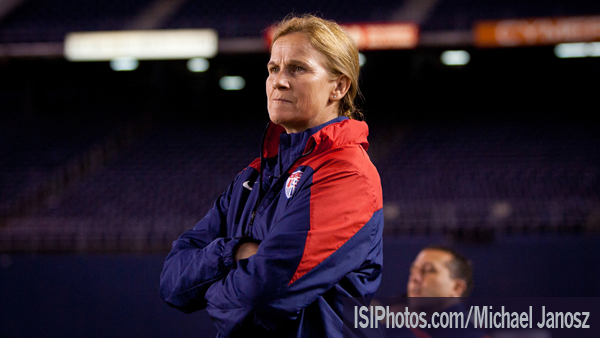USWNT: Victory over England does not quell questions about Ellis’s vision

In certain respects, the U.S. Women’s National Team’s 1-0 victory over England on Friday was a success.
The WNT did get the result, after all – albeit with the help of a wrongly-raised offside flag – which should hopefully provide a psychological boost to the players, and stop the bleeding after the defeats to Brazil and France. But considered from a slightly wider angle, with the World Cup looming, should we find this match reassuring?
Well, not exactly.
+READ: Defeat to France heightens USWNT concerns ahead of Women’s World Cup
For one, the WNT’s much-discussed new 4-2-2-2, as deployed here, was not a notable success.
The formation featured Lauren Holiday and Morgan Brian at the back of midfield, Carli Lloyd and Christen Press pinched in higher, and Abby Wambach and Alex Morgan up front — the whole forming a loose, narrow rectangle, frequently flanked by Meghan Klingenberg and Ali Krieger in the fullback spots.
But the narrowness of the formation played into England coach Mark Sampson’s strategy to cede the initiative and defend deep in two compact banks of four, while the need to keep the fullbacks high for width opened up room for England to counterattack when they did regain possession.
 And, perhaps most importantly, the spacing that the three lines of attacking players were evidently directed to maintain prevented the U.S. from getting numbers around the ball, leaving the player in possession largely isolated.
And, perhaps most importantly, the spacing that the three lines of attacking players were evidently directed to maintain prevented the U.S. from getting numbers around the ball, leaving the player in possession largely isolated.
The result, in a word, was longball. Holiday and Brian would frequently receive the ball from the center backs on halfway, find no U.S. attacking player within 15 or 20 yards, and launch it toward the forwards or the wings, generally in front of the England backline, rather than in behind.

Lloyd and Press were too often simply bypassed; or, when they did get it ended up playing long diagonals and crosses themselves. There was almost no interchange in midfield—except when recovering possession from England led to the players being out of the intended team shape.
Indeed, the one U.S. goal originated in Becky Sauerbrunn finding Holiday high on the right wing in the aftermath of a U.S. corner — not exactly her normal position under the U.S. game plan. And despite this approach being oriented toward her strengths, Wambach cut a largely peripheral figure over the course of 90 minutes, with little chemistry between she and her strike partner Morgan.

 In sum, the U.S. attack was predictable, ponderous and ineffective. For all that the U.S. were able to dominate possession against an unadventurous England and run up a sizable shot (and cross) advantage, England goalkeeper Karen Bardsley was rarely troubled.
In sum, the U.S. attack was predictable, ponderous and ineffective. For all that the U.S. were able to dominate possession against an unadventurous England and run up a sizable shot (and cross) advantage, England goalkeeper Karen Bardsley was rarely troubled.
Under the circumstances, the fact that U.S. coach Jill Ellis waited until the 89:35 mark to make her first attacking substitution (bringing in Amy Rodriguez for a brief cameo in place of Morgan) was baffling, at best.
The problems experienced by the U.S., though, are not, in the main, down to the use of a 4-2-2-2 rather than another formation.
There is nothing inherent in the 4-2-2-2, for example, that prevents fluid movement within the basic midfield “square,” requires the player with the ball to be left without short passing options, or more generally dictates resorting to the long ball.
These qualities (or shortcomings) appear to flow instead from a deeper, consistent coaching philosophy that Ellis has instituted as coach of the WNT. The U.S. has consistently spurned a short passing game through midfield in favor of lumping the ball up to the forwards, or spraying it to the wing to set up deep crosses, for months now — since World Cup qualifiers in October, at the very minimum.
The U.S. has taken this approach against weak opposition and strong, when seeking to play on the counter and when on the front foot. For all the references in interviews to tactical sophistication and fluidity and possession, this is how Ellis wants the WNT to play. And barring an unexpected shift in style, it is how the WNT will presumably play in four months at the World Cup, whether the formation is 4-3-3, 4-2-2-2 or something else.
Why it has worked out this way seems not entirely clear. It is possible that Ellis decided that she simply would not have enough time with her players to develop them into a cohesive, keep-the-ball-and-keep-it-on-the-ground side. Given the amount of lead time Ellis has had prior to the World Cup (not to mention the work done by former coach Tom Sermanni) and the players she has had available, that seems somewhat improbable; but stranger things have happened.
+READ: U.S. Soccer quietly weighing youth development overhaul as USWNT eye future
Ellis may have been unwilling — or, given Sermanni’s ouster, felt herself unable — to select a roster and set out an XI that would be comfortable in a possession-oriented style. Perhaps in Ellis’s philosophy, this style is simply how she thinks the WNT should play.
At the end of the day, though, why the WNT is to play this way is less important than whether it will work at the World Cup. And there, as we have seen over the past several months, there is considerable room for doubt.
 The WNT’s current approach has, for the most part, been left behind at the highest levels by the modern game. Organized, prepared defenses can handle the (predictable) long passes to the forwards and crosses from the wings. Rather than putting the opposition under pressure, the result is too often simply to repeatedly concede possession, and, against top teams, to spend long periods chasing the ball.
The WNT’s current approach has, for the most part, been left behind at the highest levels by the modern game. Organized, prepared defenses can handle the (predictable) long passes to the forwards and crosses from the wings. Rather than putting the opposition under pressure, the result is too often simply to repeatedly concede possession, and, against top teams, to spend long periods chasing the ball.
Indeed, one of the few times the U.S. has enjoyed noteworthy success with this game plan was against Costa Rica in World Cup qualifying, when Wambach enjoyed a 6-8” height advantage over two centerbacks not of the highest caliber — a scenario that will not likely be replicated in the World Cup. These disadvantages may explain why our notional peers (Japan, Germany, France), and indeed, even the U.S. youth national teams, as shown by the U-17s this month, have abandoned this style.
+READ: Does U.S. Soccer have what it takes to carry out its women’s youth dev. initiatives?
Nor has Ellis yet provided a reason to think that the U.S. senior team can make a better go of it. To be sure, there are plenty of other problems with the WNT right now, as well — the utter refusal to play with a specialist defensive midfielder, the insistence on forcing players out of their most natural (and most effective) positions, the failure to effectively deploy players off the bench.
Even if all of these issues were resolved, though, the underlying question of style would remain—as would the question of whether this style can lead to success at the World Cup.











